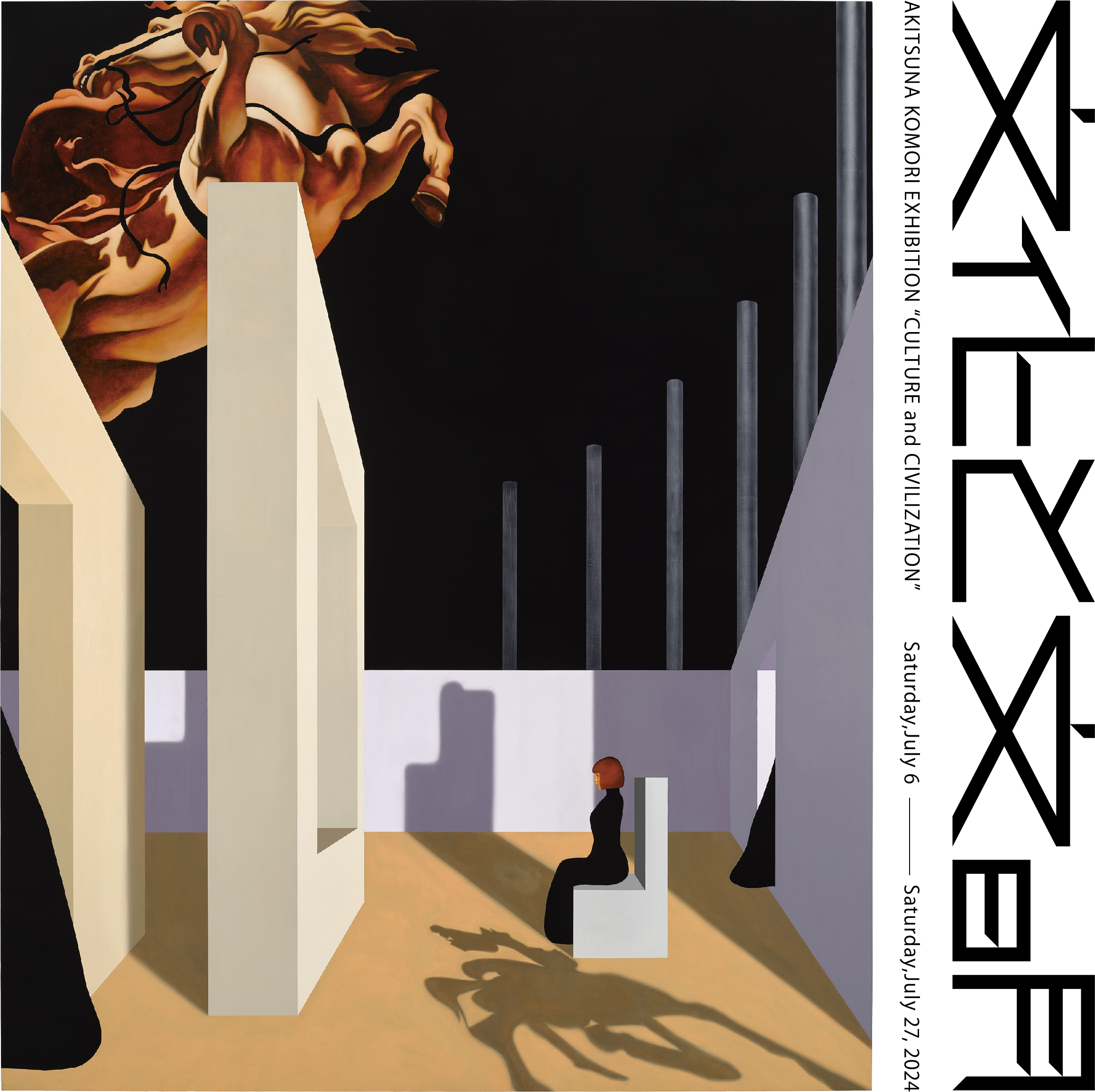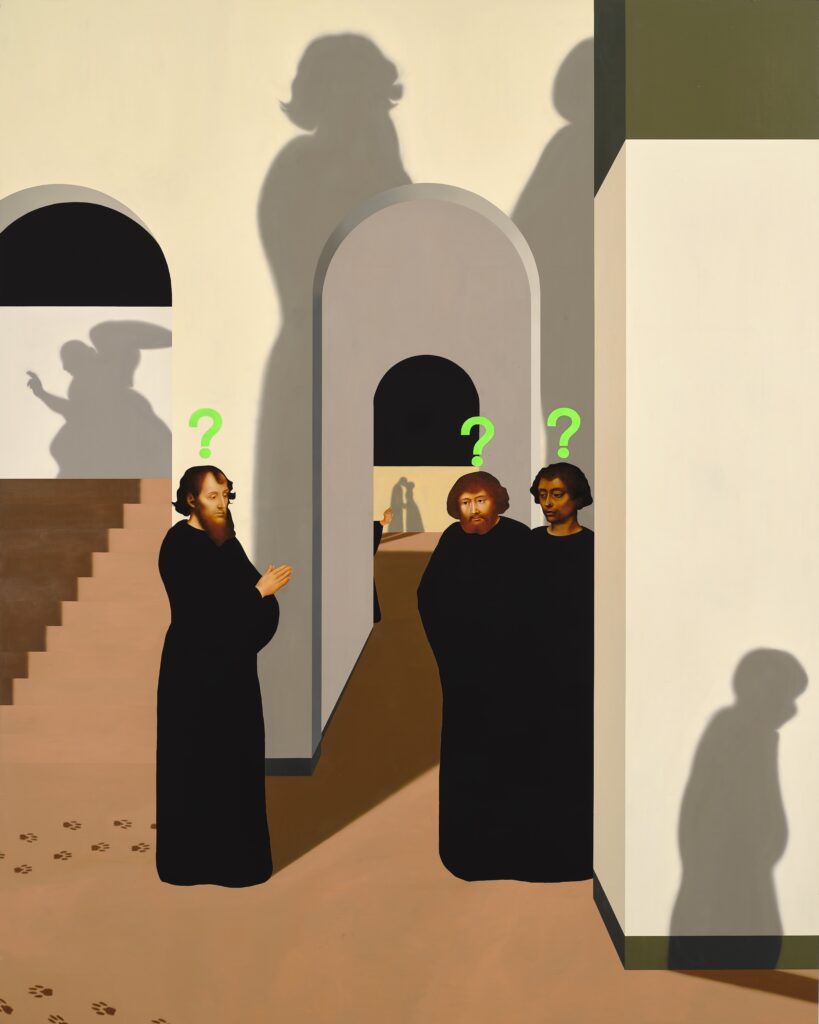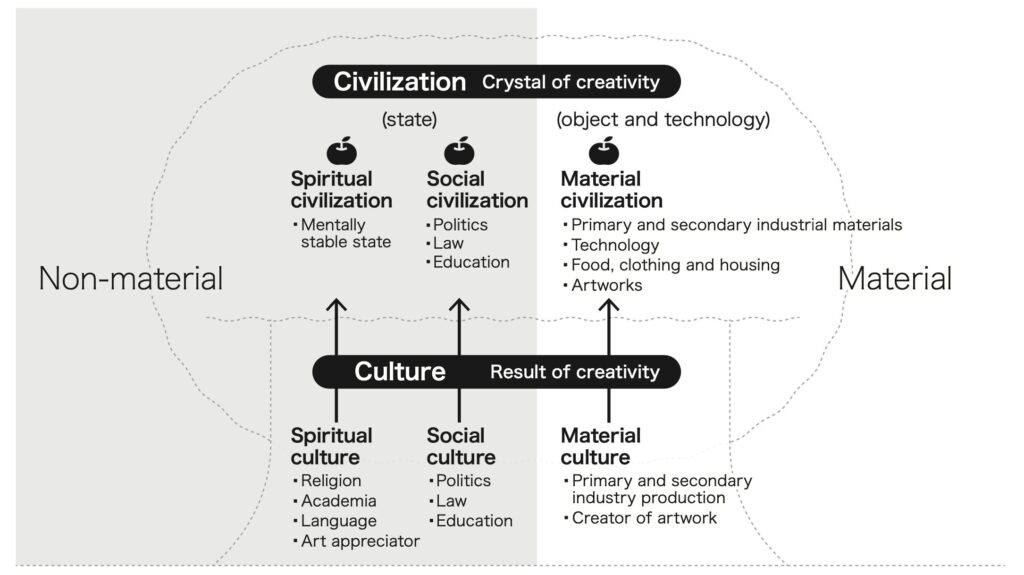
小森 紀綱 “文化と文明”
ギャラリー初個展となる本展では、特徴的な黒い衣服の絵画をはじめ、“不在の聖母”シリーズ、フレスコなど、一連の作品群の新作を発表致します。

-文化と文明の性質に基づいた宗教と芸術の関係性についての考察-
比較環境思想史、環境哲学の研究をしている吉山青翔は著書『文明と文化の概念上の非一致性(※)
において、文化と文明を次のように定義した。
文化: 人間が自分の環境に関わる間に、人間によって獲得された知識形成された人間自身の物資生活様式
・社会行動様式・ 精神活動様式からなっている複合体
文明: 文化の歴史的・進歩的な「社会的具象」と文化の進歩性をはかる尺度
吉山は文化と文明の関係について「文化は文明を支え、文明は文化の社会に対する進歩的な姿である」と論じ、
「文化は人間 による創造活動の結果であり、文明は人間による文化の実践活動の結晶である」と結論付けている。
下の図は、吉山青翔「文明と文化の概念上の非一致性」の概念関係を本展示のために再編したものである。

古代より宗教は精神文化の中心を担い、宗教の種別や地域による差異は含まれるものの、その属性は教育や芸術、医療など 多岐に渡っていた。次第に科学の発展や社会的分業に伴ってそれらの役割は失われつつあり、現在では集団内での倫理や儀式としての機能が中心となっている。
(※)吉山青翔「文明と文化の概念上の非一致性」『四日市大学環境情報論集』2006年,9巻,2号
- 期間:2024.7.6 (土) – 7.27 (土)
- 時間:12:00 – 19:00 休廊日:日曜 , 月曜 , 祝
- 場所:HENKYO ( 東京都渋谷区神宮前5丁目9-15-B2F)
HENKYO is pleased to present Culture and Civilization, a solo exhibition by Akitsuna Komori
In his first solo exhibition at the gallery, Komori will present a wide range of works, from his characteristic paintings of black garments, to his “The absent mother ” series and Fresco works.
– Study on the Relationship between Religion and Art Based on the Nature of Culture and Civilization – Seisho Yoshiyama, a researcher in the history of comparative environmental thought and environmental philosophy, defined culture and civilization in his book “The Conceptual Discrepancy of the Civilization and Culture”(*) as follows.
Culture : a complex consisting of man’s own material lifestyle, social behavioral style, and spiritual activity style, which is formed by the knowledge acquired by man as he interacts with his environment.
Civilization : a historical and progressive “social embodiment” of culture and a measure of cultural inventiveness.
He argued that “culture supports civilization, and civilization is the progressive form of culture to society,” regarding their connection, and concluded that “culture is the result of human creativity, and civilization is the crystal of the practical activity of culture by humans. The chart below is a rearrangement of his conceptual relationship for this exhibition.

Religions have played a central role in spiritual culture since ancient times. Although there were differences among religious types and regions, the attributes of religion varied widely, including education, art, and medicine. Gradually, with the development of science and the social division of labor, these roles were lost, and now their main function is as ethics and rituals within a group.
On the other hand, artistic civilization has also served as a means to develop religious culture. For example, paintings and sculptures in churches served to visually convey information to illiterate people. The subjects of these works were mainly religious teachings and prayers, which is why Western art history and Christianity are so closely tied together today.
Even before the emergence of specific groups and organizations such as Christianity and Buddhism, artistic civilization has functioned as a tool for the evolution of religious culture. The connection between religion and art can be seen in the traces of prayer: the prehistoric cave paintings of Lascaux and Altamira, and the patterns on Jomon pottery.
Religion and art are often questioned as being necessary in society. However, they arise in the process of creating human civilization and are considered to “exist” before their necessity. Therefore, it is impossible for only one of them to exist, and it can also be said that they are “two sides of the same coin”; they share spiritual culture and aim for spiritual civilization.
(*) Seisho Yoshiyama, (2006), The Conceptual Discrepancy of the Civilization and Culture, Yokkaichi University Journal of Environmental and Information Sciences, Vol.9, No.2
- Saturday 6th July to 27th Saturday July 2024
- 12:00-19:00 (Closed on Sundays and Mondays)
- Opening Reception : 5th July (Fri) 19:00-21:00
